Birds are one of nature’s most versatile and diverse groups. From hollow bones that allow them to fly to feathers that help conserve body heat, birds boast a wide variety of adaptations that help them survive across the globe.
One such adaptation is the long neck. This is typically an adaptation for water birds, allowing them to forage for food underwater.
9 Common Birds with Long Neck
Let’s take a look at these long-necked birds!
1. Whooping Crane

- Scientific name: Grus americana
- Size: 59.1 in (150 cm) in length
- Weight: 211.6-275.1 oz (6000-7800 g)
- Wingspan: 90.2 in (229 cm)
Often described as living dinosaurs, the whooping crane is the towers over all other North American birds in terms of height. Both male and females have identical color patterns, boasting black wingtips, black legs, and a red mask on their faces and heads.
A handful of populations spend the winter in the southern US in Wisconsin through Florida, Louisiana, and southern Texas. The whooping crane lives in wetlands and marshes, eating invertebrates, plant material, and even small vertebrates such as minnows and frogs.
The Texas population migrates to Canada to breed. The other populations have been established via captive-breeding and reintroduction programs and are non-migratory. However, innovated efforts to teach the reintroduced populations how to migrate are underway.
Males and females build nests together in shallow water, such as lake margins. Using vegetation to hide their nest site, they will flatten sedges, cattails, and bulrushes to create a flat or slightly depressed area for the eggs.
Fun fact! Whooping cranes are one of conservation’s most successful stories. In the 1940’s the total number of whooping crane individuals was 20. However, as a result of captive breeding programs and wetland management, there are currently 600 individuals!
2. American Flamingo
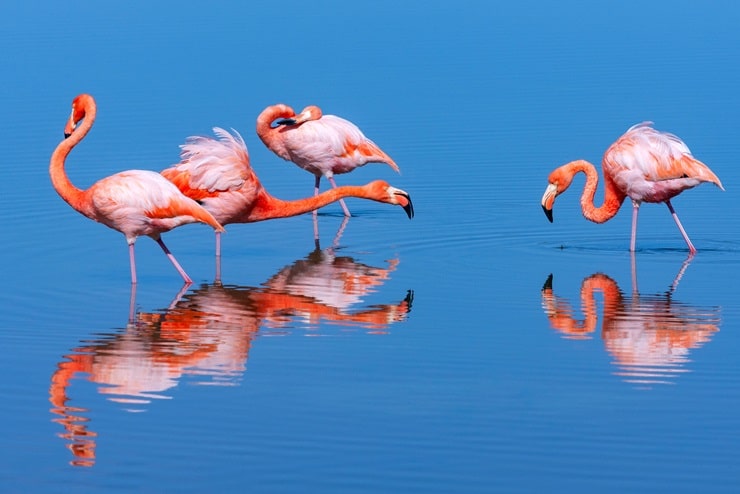
- Scientific name: Phoenicopterus ruber
- Size: 47.24-57.09 in (120-145 cm) in length
- Weight: 74.08-144.62 oz (2100-4100 g)
- Wingspan: 55.12-64.96 in (140-165 cm)
One of the most recognizable birds, the American flamingo is known for its pink plumage, long legs, and long neck. The females are smaller and shorter, but boast the same vibrant pink coloration.
American flamingoes can be found across the Caribbean Sea and along South America’s northern coasts. There is also a population in the Galapagos. In these areas, they are found in saline and brackish lagunes. These lagunes provide the perfect selection of aquatic invertebrates (such as crustaceans, mollusks, and insects) for the flamingoes to feed on.
While the Galapagos population is sedentary, most flamingo populations are at least partially migratory. They have been found in Cuba, the Bahamas, and Mexico.
Breeding American flamingoes will gather in large colonies on mudflats and islands where they will construct nests out of mud. Note that the Galapagos population is once more different, choosing instead to make nests out of stone.
Fun fact! American flamingoes have a special adaptation on their bill called lamellae. These are tooth-like ridges on the outside of the bill that allows them to filter food from the water -a built-in strainer!
3. Roseate Spoonbill
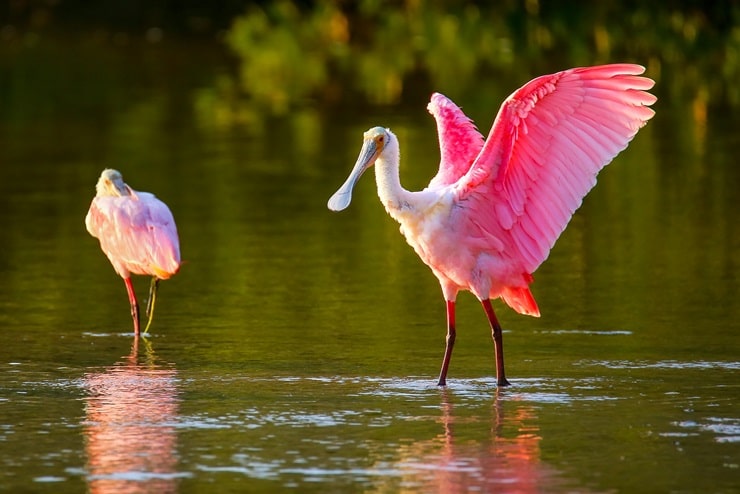
- Scientific name: Platalea ajaja
- Size: 27.9-33.9 in (71-86 cm) in length
- Weight: 42.3-63.5 oz (1200-1800 g)
- Wingspan: 47.2-51.2 in (120-130 cm)
Lesser known than flamingoes, roseate spoonbills are America’s own pink bird! Their pale pink body is accented by brighter pink rump and shoulders and is complemented by a white neck and yellowish-green head.
One of their most distinguishing features is their large spatula-like bill.
Roseate spoonbills are year-long (i.e., non-migratory) residents of eastern and northern South America. They are also found all along Mexico’s eastern and western coast, the southern Texas coastline, and southern Florida.
Roseate spoonbills are not picky about their habitat, and are able to live in either fresh, brackish, and marine water! This includes bays, mangroves, forested swamps, and wetlands.
They stick to the shallows, foraging for crustaceans (e.g., shrimp, prawns, aquatic insects, and fish). They forage by sweeping their bills through the water, keeping their bill opened until they feel the prey.
During the breeding season, spoonbills will gather with egrets, ibises, and herons (more long-necked birds!) and build their nests on islands. Males will collect the sticks while the females will build the nest.
Fun fact! As roseate spoonbills get older, their heads bald – a phenomena many of us can sympathize with.
4. Gray Crowned Crane
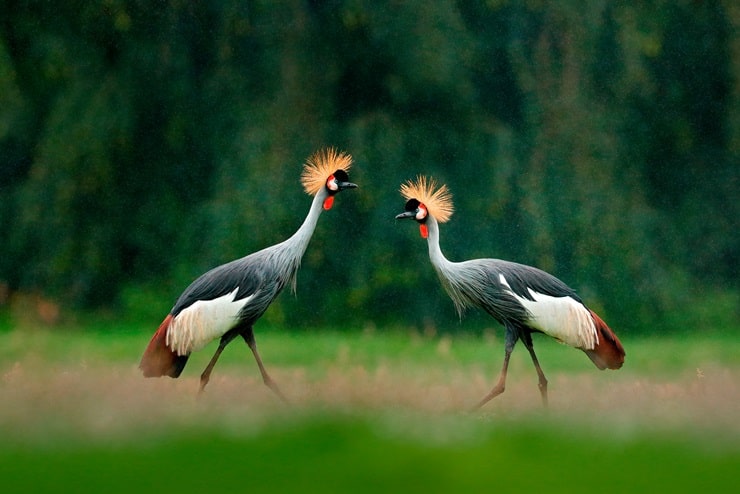
- Scientific name: Balearica regulorum
- Size: 39.37-43.34 in (100-110 cm) in length
- Weight: 105.8-141.1 oz (3000-4000 g)
- Wingspan: 70.87-78.74 in (180-200 cm)
Related to the whooping crane, the gray-crowned crane boasts a crown of ornamental yellow-orange feathers. Its black and gray body is accented by a rufous rump and patch of orange feathers on the side.
They are found throughout southern and eastern Africa in countries such as Kenya, Uganda, Zambia, and South Africa. They are non-migratory, thus remaining in this range year-round.
Gray-crowned cranes prefer the habitat of mixed wetlands and grasslands. They will eat seed heads of grasses, insects, and small animals such as frogs and crabs.
Gray-crowned crane’s breeding seasons are tied to rain. During appropriately rainy seasons, they will build their nests on the edges of wetlands, making sure to conceal their nests among the plant matter.
Fun fact! Gray-crowned cranes will sometimes stomp on the ground in order to disturb insects to eat.
5. Limpkin
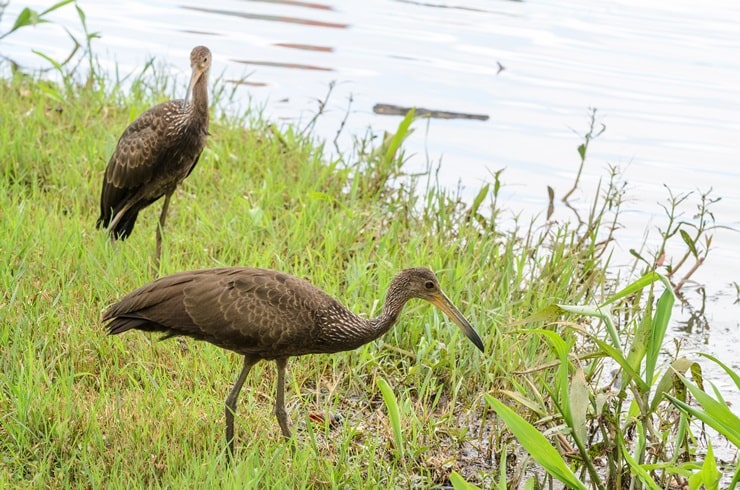
- Scientific name: Aramus guarauna
- Size: 20.0-28.7 in (63.5-72.9 cm) in length
- Weight: 37.0-48.3 oz (1050-1370 g)
- Wingspan: 39.8-42.1 in (101-107 cm)
The limpkin is shaped similarly to herons, with long legs and a long neck. They are brown with white speckling, which is especially pronounced on their neck and back. Make note of their long, thick beaks that curves slightly downward.
Limpkins are found throughout most of northern and central South America, as well as southern Mexico, and Florida. These species are non-migratory, though they will be found far from their range during times of drought.
Limpkins are adapted to eating snails. However, they will also eat seeds, insects, lizards, frogs, and crustaceans.
Limpkins are not picky about where they place their nest. Typically, however, the male will choose a spot that is close to the water and partly hidden. Nests have been found in tall grasses, on floating vegetation, in tree cavities, and even in old Osprey nests!
Fun fact! When limpkins fly, their outermost flight feather makes a buzzing noise. This is thought to be a way to mark their territory.
6. African Sacred Ibis
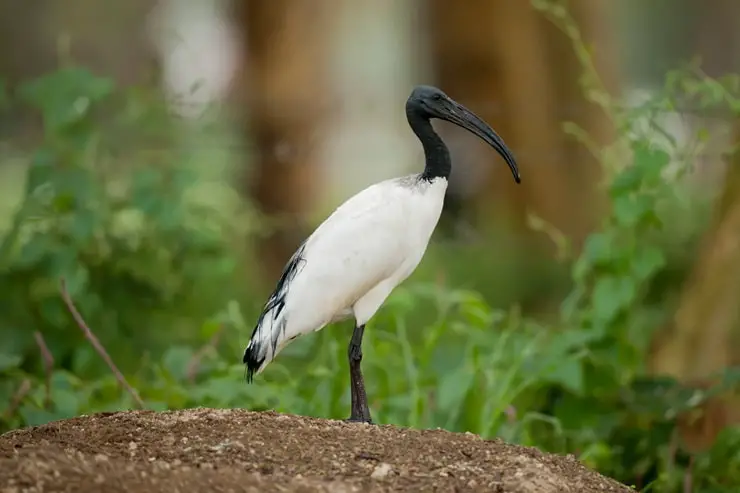
- Scientific name: Threskiornis aethiopicus
- Size: 25.59-35.04 (65-89 cm) in length
- Weight: 53.97 oz (1530 g)
- Wingspan: 44.09-48.82 in (112-124 cm)
The African sacred ibis is characterized by a black bill, head, and neck and a white body. During the breeding season, they develop black ornamental plumage near their rump.
The African sacred ibis is found throughout much of Africa, commonly across sub-Saharan Africa. It is also found, though less commonly, in West Africa and Southern Iraq.
Their habitat is varied and includes inland freshwater wetlands, sewage works, grasslands, fields, lagoons, and offshore islands.
Their migration is linked to rain. Birds north of the equator move northwards, while those south of the equator move southwards.
African sacred ibises eat mainly insects, such as locusts, grasshoppers, crickets, and beetles. However, they will also feed on larger prey, such as crustaceans, fish, small mammals, and even eggs of other birds!
The ibises will nest in trees such as mangroves or on bare ground on rocky islands. The nest is a large platform made by the females of the sticks and branches that the male gathers.
Fun fact! The ibis is called “sacred,” because in ancient Egyptian society it was worshiped as the god Toth and was thought to preserve the country from plagues and serpents. Oftentimes, African sacred ibises had the honor of laying next to pharaohs as mummies themselves.
7. Black-necked Stork
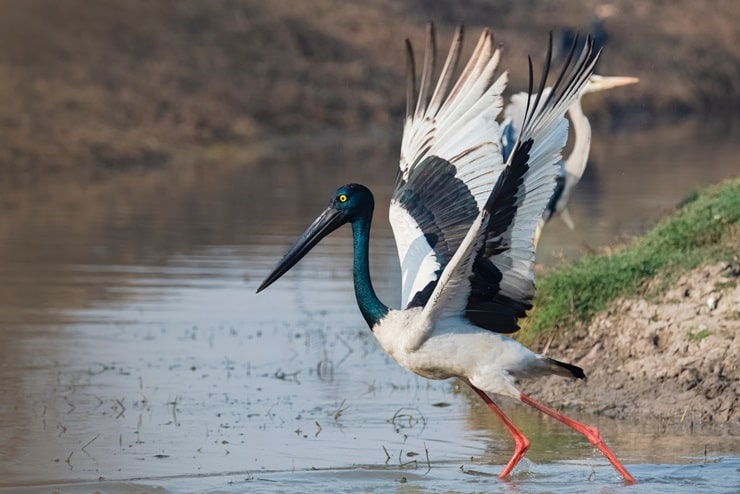
- Scientific name: Ephippiorhynchus asiaticus
- Size: 43.31-53.94 in (110-137 cm) in length
- Weight: 144.64 oz (4100 g)
- Wingspan: 74.8-85.83 in (190-218 cm)
Storks make up an important part of our modern mythologies as the deliverers of newborn babies. Though there is some debate as to whether the original story referred to herons or cranes, undoubtedly storks remain a striking species in and of themselves.
Specifically, the black-necked stork is characterized by a greenish-black head and neck as well as black underwings. A way to distinguish males and females is to look at the iris. The male’s irises are dark brown and the female’s irises are yellow.
The black-necked stork is found in Sothern and Eastern Pakistan, Nepal, India, Sri Lanka, mainland southeast Asia, as well as northern and eastern Australia.
They are sedentary and do not migrate. Their preferred habitat is freshwater wetlands, such as swamps, rivers, lakes, lagoons, flooded grassland, and water meadows.
The storks will eat fish, eels, catfish, frogs, snakes, turtles, mollusks, and beetles. They have also been known to capture smaller waterbirds and swallow them whole!
Black-necked storks will build huge stick nests lined with rushes, leaves and grass. They prefer to find isolated trees and build their nests at the very top.
Fun fact! In Australia, this bird is known as the jabiru.
8. Great Egret
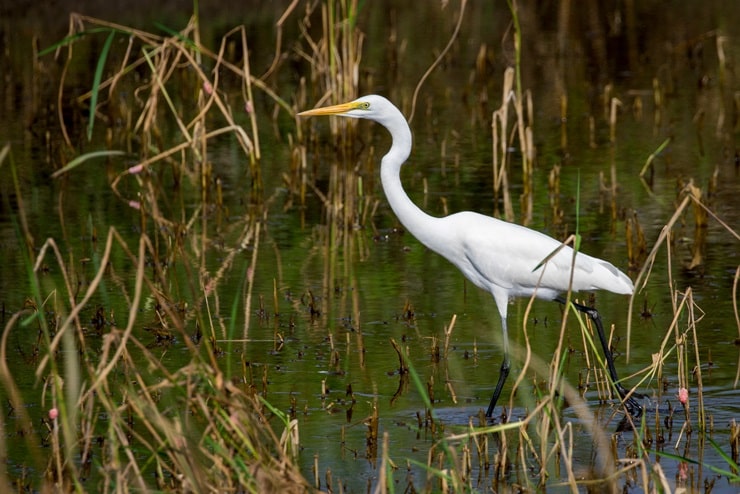
- Scientific name: Ardea alba
- Size: 37.0-40.9 in (64-104 cm) in length
- Weight: 35.3 oz (1000 g)
- Wingspan: 51.6-57.1 in (131-145 cm)
The great egret’s pure white feathers are accented by its yellow bill and black legs.
They are found year-round throughout most of South America, Mexico’s coastline, and the southeastern US. During their breeding season, you can find great egrets throughout most of the central and eastern US. And lastly, during the breeding season, they stay in California and all of Mexico.
Great egrets thrive in wetlands. They can live in brackish water, freshwater, and marine wetlands. Here they hunt for small fish, though they can also eat amphibians, reptiles, birds, small mammals, and invertebrates.
When breeding, males will choose the nest site and build the platform. Only then, does he court and mate with a female who will then potentially help to complete the nest.
Fun fact! Great egret nestlings will often kill the smaller nestlings if breeding conditions are poor. Survival of the fittest from birth!
9. Great Blue Heron

- Scientific name: Ardea herodias
- Size: 38.2-53.9 in (97-137 cm) in length
- Weight: 74.1-88.2 oz (2100-2500 g)
- Wingspan: 65.8-79.1 in (167-201 cm)
Our last bird on the list is a familiar North American bird and a cousin of the Great Egret. Their long neck and legs, subtle blue plumage, and black stripe over the eye, as well as their propensity for standing completely still in search of prey make them easily recognizable.
They are found throughout all of Mexico during their non-breeding season. During the breeding season, they are found throughout the entire US and most of Canada.
They can be found in both saltwater and freshwater habitats, eating anything from fish and frogs to insects and small mammals. They will often shake their prey to break spines before swallowing them whole.
Great blue herons nest mainly in trees. They will nest in colonies of up to 500 pairs. The male will collect sticks and bring them to the female who weaves a saucer-shaped nest.
Fun fact! Great Blue Herons have benefited greatly from the recovery of beaver populations. This is because beaves help create a patchwork of swamps and meadows that provides a perfect habitat for the herons.
